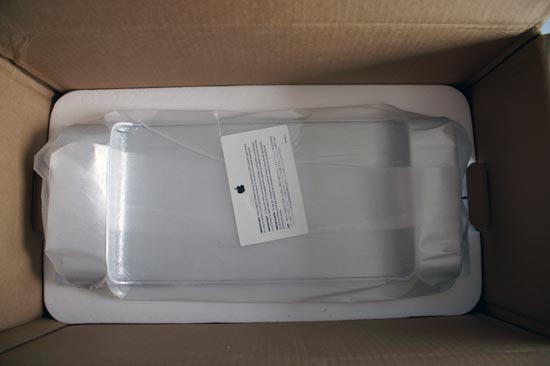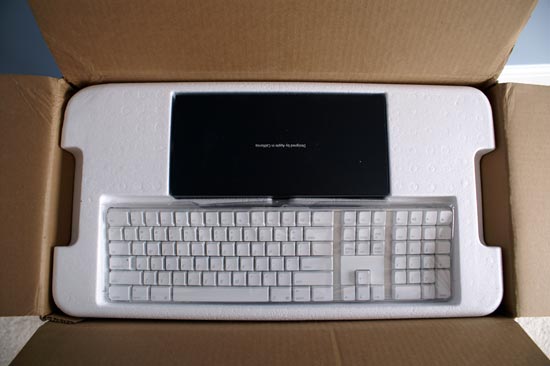Apple's Mac Pro - A True PowerMac Successor
by Anand Lal Shimpi on August 16, 2006 12:27 PM EST- Posted in
- Mac
It's here, it's quiet and it's fast; we got our Mac Pro on Friday and spent every day since taking it apart, using it and benchmarking it. There's far too much to include in one review, so we're breaking it up into three parts. We've already published the first part of our coverage last week, where we discussed the specifications of the new system as well as inadvertently turned the article into a primer on the implications of the FB-DIMMs that the Mac Pro uses. So if you want a brief two-page technical overview of FB-DIMMs, you'll want to consult that article.
Part two is what you're reading today; here we're going to be looking at the Mac Pro as a Mac (mostly) and compare the performance of two speed grades (2.0GHz and 2.66GHz) to the outgoing PowerMac G5. We'll also take the thing apart and give you a nice tour in pictures of the new chassis.

PowerMac G5 (left), Mac Pro box (guess where)
The third and final part will have two focuses - DIY upgrades (e.g. swapping CPUs and sticking in your own FB-DIMMs) as well as performance under Windows XP. Apple just released an updated version of Boot Camp with support for the Mac Pro that should hopefully address some of the serious performance issues we ran into while running Windows XP on our machine. Give us a week and you'll have part 3 to peruse at your leisure.
With our plan of attack laid out, it's time to dive into the Mac Pro and we'll start where very few Mac users like to: at its price. In the past we've generally shied away from getting too caught up in the price debate, because honestly if you're buying a Mac, you're doing so because of the OS and assigning value to that is difficult. Some users are content with other OSes and see no value in OS X, and to them the value in a Mac is simply the total cost of the components that make up the machine. At the same time there are other users who prefer OS X and thus find additional value in a system that is able to run that OS. Regardless of which camp you fall into, the Mac Pro is competitively priced. We'll let the table below do the talking:
|
Apple Mac Pro |
Dell Precision Workstation 490 |
Home Built Config |
|
|
CPU |
2 x Xeon 5150 (2.66GHz) |
2 x Xeon 5150 (2.66GHz) |
|
|
Memory |
2x 512MB DDR2-667 FB-DIMMs |
2x 512MB DDR2-667 FB-DIMMs |
|
|
Graphics |
GeForce 7300 GT |
Quadro NVS 285 |
|
|
Hard Drive |
250GB SATA 3Gbps |
250GB SATA 3Gbps |
|
|
Optical |
SuperDrive (DVD+R DL/DVD+-RW/CD-RW) |
16X DVD+-RW |
|
|
Notes |
Free 17" LCD, had to add sound card, mouse and 1394a card |
Includes Supermicro X7DAE motherboard priced at $474; does not include price of OS, case or power supply |
|
|
Price |
$2499 ($2299 with educational discount) |
$3110 |
$2390 |
The Dell is clearly more expensive, although you can knock off $100 - $200 thanks to the bundled LCD (unfortunately Dell gives you $0 credit if you remove the monitor from your order). We're able to come close with our own configuration by shopping at Newegg and other vendors through our shopping partner, but note that the $2390 total does not include an OS, case or power supply.

If you're in the market for a dual socket dual core Xeon workstation, Apple's Mac Pro is definitely a bargain. The only real issue here is that not everyone needs or can adequately use a dual socket Xeon workstation, in which case you can argue that there's better value in a cheaper single socket Core 2 system. Unfortunately Apple does not offer any such system, which leads us to believe that we'll either eventually see the introduction of a cheaper single socket Mac Pro or maybe even a new product line simply called the "Mac" that uses desktop Core 2 processors instead of their Xeon counterparts.
Bottom line? The default configuration of the Mac Pro is priced very competitively for what you get; whether or not you need what you get is a different discussion entirely.












96 Comments
View All Comments
plinden - Thursday, August 17, 2006 - link
I know of at least one multithreaded LAME encoder for iTunes, but I've never used it so don't know how fast it is - http://www.versiontracker.com/dyn/moreinfo/macosx/...">http://www.versiontracker.com/dyn/moreinfo/macosx/...Maury Markowitz - Wednesday, August 16, 2006 - link
The MP3 process itself might not be, but the load -> encode -> write process most certainly is threadable.Maury
Questar - Wednesday, August 16, 2006 - link
Reading and writing a file most likely doesn't use very much in system resources.Dennis Travis - Wednesday, August 16, 2006 - link
Good job Anand. I can't wait for the next part!!WeirdZen - Wednesday, August 16, 2006 - link
Something I have not seen mentioned is support for Video Cards. Now that these are using a different Bios, can we use standard PC Video Cards, or are we still forced to pay too much money for a slim selection of cards?Maury Markowitz - Wednesday, August 16, 2006 - link
The basic answer is "no, but it is likely you can make them work with some effort". There are two basic problems, one is the boot firmware on the card, and the other is the drivers in the Mac OS (or lack thereof). Both can be addressed, and have been in the past. Here's the scoop:The firmware on the basic PC card is basically aimed at getting a BIOS-based machine up and running. Since the Mac uses EFI, this doesn't work, and a PC card in a Mac simply won't boot (nothing bad happens though, just nothing happens). The Mac cards replace this BIOS-based code with one that appears to work fine on both BIOS and EFI machines. So basically a Mac card will work fine in any PC, but most PC cards will not run in the Mac. EFI is expected to become more common in the future though, so we'll have to see how this turns out six months from now.
Now it's just firmware. That means you can download it from a Mac version and upload it to a PC version and presto. The problem here is that the combination on the Mac drive ends up being larger, which shouldn't be surprising. So while most PC cards have a 64k flash on them for the firmware, the Mac version is about 110k and needs a 128k flash. SOME PC cards have this, but generally it's rare.
Things are not so bad as they seem. In the past hackers have been able to strip out the PC-only code, leaving a smaller Mac-only version that will fit into 64k. It will be a little while before we know if this is possible for the EFI driver too, it's simply too early to know yet. Another option is to solder a 128k flash onto your card, but obviously that's much more "serious".
The other issue is the drivers in the Mac OS. Every card has a unique ID and vendor code in it, and the Mac OS tries to look up cards by pattern matching on these IDs. So even if you did flash the firmware, the Mac wouldn't find the driver matching those codes, and fail to load it. The news here is very good though, because Apple puts practically everything into normal text files, including these codes. It's a triviality to find them in the driver and change them to match your card.
So we'll all just have to wait a bit and see how it all turns out. The basic long-n-short is that its definitely _possible_ in theory.
Finally, a word or two about SLI/CrossFire. These are a different matter entirely. Basically these systems use custom drivers that split every message being sent out of the video drivers and sends them to both cards at the same time. That way they both have an identical copy of the "world". Clearly the normal drivers cannot be used, and unless someone makes a driver for the Mac, these things simply aren't going to work.
There is one oddball though, the GeForce 7950 GX2. This card is basically two 7900's bolted together, with SLI _internal_. From what I understand, the machine and OS has no idea that it's not talking to a bog-standard 7900. Assuming all the problems above can be worked out, it is just possible that the Quattro driver Apple has now could be adapted to work with this card. THAT would be good enough for me, Halo runs full-screen on a 30" LCD on this card...
Maury
Pirks - Wednesday, August 16, 2006 - link
yeah Anand please tell us if we can buy nice cheap evga 7900GT and stick it inside this fruity beastVooDooAddict - Wednesday, August 16, 2006 - link
I think this is a burning question amoung those of us thinking about this beast.ViRGE - Wednesday, August 16, 2006 - link
Early results look like it won't happen. For Mac OS X, the card needs to support EFI, which means there needs to be a portion of the video BIOS programmed to handle it. Right now only Mac-specific cards seem to be able to do so, and PC cards can't be flashed because the Mac cards are using a larger EEPROM for the BIOS.delta53 - Wednesday, August 16, 2006 - link
They go on and on about the price difference and fail to tell you that the Apple doesn't include at monitor or a protection plan which the price of the dell includes both. The price for the apple plan is $249 for 3 years. Dell will take off $149 for the monitor. Therefore, the Apple with protection plan without monitor is $2748.00 and the Dell with the protection plan without monitor is $2961.00. Price difference $213.00. That is comparing apples to apples.